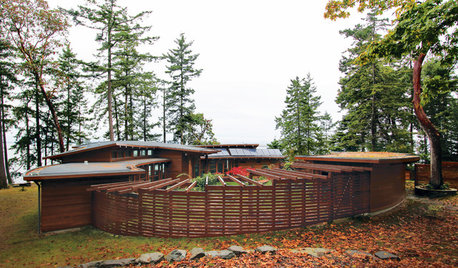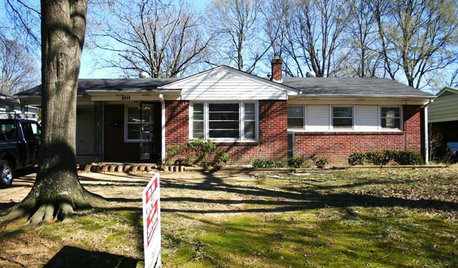Whole house surge protection
We are beginning our kitchen reno, and I am surprised by the price (!) and sophisticated circuit boards of the Miele DW and SZ fridge we are planning. Does anyone get whole house surge protection when they remodel their kitchen to protect their new, expensive kitchen appliances?
Thanks!
Comments (29)
library_girl
11 years agolast modified: 9 years agoI think it's a small charge for the protection it provides, not just for the kitchen, but also for the TVs and computers. We had to upgrade our electric, so we had a 200 amp surge protection unit from Continental Power installed. Here's all the info my electrician sent on our options and their pricing. I'm not sure how much he charged us to install it, because it was included in our upgrade package:
Sycom surge company is a good company.
The following prices are for the items but installation and extra materials are on top of that.
It normally doesn't take long to install it (maybe like 15 to 30 minutes)
Sycom surge 200amp panel protection unit ~ $80
Sycom surge High speed coax ~ $95
Sycom surge Analog system coax ~ $95
Sycom surge Phone (1 Line) protection ~ $29
Sycom surge 6way, phone, coax protection ~ $37There is another 200amp surge protection unit that I sell that is from Continental Power. (I have this one personally)
It does more than just surge protection, it also increases the power factor to every motor that is in your house like frig, dishwasher, a.c. unit, furnace and ect., this reduces the electric bill because you don't lose the electricity to your motors like it does normally. It also reduces the harmonic noises.
Take a look at this item on http://continentalpowerworx.com/ it's called powerwoRxe3 and is at the bottom of home page.
It's a great unit.
The cost of this powerwoRxe3 unit is $675.Here is a link that might be useful: powerwoRxe3 - at the bottom of home page.
gayl
11 years agolast modified: 9 years agoI think it is a very good idea. We had one added to a vacation home. The cost was $100 for the part, $100 for the install for the whole house. We just built a house and had one installed and the cost was similar. I think you can get a something at a far lower cost than library_girl is quoting. And we have had no problems since installing these.
Related Professionals
Amherst Kitchen & Bathroom Designers · Clute Kitchen & Bathroom Designers · Hammond Kitchen & Bathroom Designers · Adelphi Kitchen & Bathroom Remodelers · Fullerton Kitchen & Bathroom Remodelers · Brentwood Kitchen & Bathroom Remodelers · Champlin Kitchen & Bathroom Remodelers · Spokane Kitchen & Bathroom Remodelers · Langley Park Cabinets & Cabinetry · Bonita Cabinets & Cabinetry · Christiansburg Cabinets & Cabinetry · Little Chute Cabinets & Cabinetry · Newcastle Cabinets & Cabinetry · La Canada Flintridge Tile and Stone Contractors · Glassmanor Design-Build Firmsskyedog
11 years agolast modified: 9 years agoWe put a whole house surge protector in when we got a plasma a few years ago. They are not very expensive and I really do believe they extend the life of your electronic goods. We have an old house so there has been a lot of wiring updates over the years.
The electrician that did the install put some of our more expensive electronic goods on dedicated ciruits also. He thought even in house surges like from vacuum cleaners and such had a negative impact. I don't know if it's true or not but it was a cheap and easy precation just in case.
cakelly1226
11 years agolast modified: 9 years agoAfter a neighborhood kid crashed into a utility pole and the resulting turn on of power caused a surge and we lost ALL of our appliances but our very expensive plasma tv(THANK GOD!), we got one. It is WELL worth the cost. We only got back 345 from the kid's insurance for our losses and were not able to write it off due to the settlement. It ended up costing us about 3500 in lost appliances(luckily our cheaper ones).
gone_south
11 years agolast modified: 9 years agoWe have a whole house surge protector for our barn/apartment and another for the house we are building. The well pump and the eventual electric entry gate are also covered. Lightening is an expensive habit around here, and this seems like the best protection we can find.
brickeyee
11 years agolast modified: 9 years ago"the resulting turn on of power caused a surge "
Turning the power on is not fast enough to cause surge damage.
Lightning hitting a line, or a higher voltage line making contact with a lower voltage line are the typical culprits.
A while house protector is not all that is needed.
You should protect each high value device with it own unit also.sprtphntc7a
11 years agolast modified: 9 years agoVery informative thread!! Especially with summer upon us!!
can anyone recommend specific products to ask for?we have an electrical warehouse near us and i can get it myself but i need more info. like what to ask for and what is best/necessary, what will do the job.
i do know these range in price from $70 and up, so i need specific info on what to ask for/ what i need.
we have a 200 amp service.
Any info would be great, TIA!!
cakelly1226
11 years agolast modified: 9 years agoBrickeyee- Just to clarify I didn't mean when WE turned on the power in our individual home, rather the electric company when they turned back on the transformer, it caused the whole neighborhood to experience a surge. It was to the tune of over 600,000 and they put the full blame on the kid who hit the transformer and refused to take any responsibility. We were out of town but our neighbor said that when they turned the power back on sparks were shooting out of their sockets! Our electrican recommended a whole house protector after the incident since the surge that was caused would have been stopped by a whole house protector.
partyof7
Original Author11 years agolast modified: 9 years agoThanks so much. It does seem to make a lot of sense and is a moderate expense in the whole kitchen reno budget. I am glad I haven't yet completed the contract with my contractor. I'll definitely add this on! (I wonder if they would have suggested it??)
Library_girl, Thanks for the detailed info, prices and links. Helps a lot!
CKGM, How awful to experience that freak accident and the cost and inconvenience of replacing everything. yikes. But, sounds like you were able to upgrade your appliances, right? Bonus!
Rococogurl, Thanks for the info, I'm looking up AVR and UPS!
Appreciate all of you! Thanks
Ilene Perl
11 years agolast modified: 9 years agoThis thread was interesting, I never knew/thought of a house surge protection, but I'm interested in having this for sure.
westom
11 years agolast modified: 9 years ago> Our electrican recommended a whole house protector after the
> incident since the surge that was caused would have been
> stopped by a whole house protector.Just to be clear here. No protector stops a surge. Some protection systems have no protector. But every solution always has what absorbs surge energy - earth ground.
Too many are discussing a 'whole house' protector as if it was some magic solution. Some systems connect a surge to earth via a wire. Others use a protector to make the same connection. But most attention should focus on what does protection. Single point earth ground.
How to make a protector more effective? Upgrade the earthing.
A protector without earthing is ineffective. Any protector that 'stops' a surge is best called a scam. Protection means connecting that 'kid hit the telephone pole' surge to earth. Then nothing inside is damaged.
How good is your protector? How low is its impedance to earth? Impedance means a protector connects short (ie 'less than 10 feet') to earth ground. That low impedance connection is why a 'whole house' protector does "99.5% to 99.9%:" of the protection. Making earth ground better is a critical task in any protection system. Even some electricians do not understand the concept.
katsmah
11 years agolast modified: 9 years agoWith my kitchen remodel, I had to have the electric panel upgraded and moved (it was just a few inches away from the gas main) so I had the electrician add a whole house suppressor at the same time. The system was also properly grounded to current code. Total cost for the suppressor and it's installation was about $400 or so. With the electronics that are now in all appliances, it seemed like pretty cheap insurance. We used this Leviton protector. I have UPS units for my desktop PC and TV/entertainment system.
Here is a link that might be useful: Leviton protector
bud_
11 years agolast modified: 9 years agoThe best information on surges and surge protection I have seen is at:
http://www.lightningsafety.com/nlsi_lhm/IEEE_Guide.pdf
- "How to protect your house and its contents from lightning: IEEE guide for surge protection of equipment connected to AC power and communication circuits" published by the IEEE in 2005 (the IEEE is a major organization of electrical and electronic engineers).
And also:
http://www.nist.gov/public_affairs/practiceguides/surgesfnl.pdf
- "NIST recommended practice guide: Surges Happen!: how to protect the appliances in your home" published by the US National Institute of Standards and Technology in 2001The IEEE surge guide is aimed at people with some technical background.
westom wrote:
"How to make a protector more effective? Upgrade the earthing."The author of the NIST surge guide has written "the impedance of the grounding system to `true earth' is far less important than the integrity of the bonding of the various parts of the grounding system."
Worry about the length of the ground wire from cable and phone entry protectors to the common connection point on the power earthing system. The NIST surge guide suggests that the major cause of equipment damage is high voltage between power and phone/cable/... wires. The IEEE surge guide has an example of a ground wire that is far too long (30 ft)starting page 30.
westom wrote:
"A protector without earthing is ineffective. Any protector that 'stops' a surge is best called a scam"How fortunate that protectors do not claim to "stop" surges.
westom wrote:
"Protection means connecting that 'kid hit the telephone pole' surge to earth. Then nothing inside is damaged."This was probably a crossed high voltage distribution wire with the wires to houses. The MOVs (the voltage limiting elements) in both service panel protectors and plug-in protectors can handle thousands of amps for the very short duration of a surge. They will be rapidly burned out by the far longer duration of a crossed wire. A UPS may disconnect and provide protection. Some plug-in protectors are supposed to disconnect also - never seen one.
westom wrote:
"That low impedance connection is why a 'whole house' protector does "99.5% to 99.9%:" of the protection."The 99+% numbers come from the IEEE "Green" book. They are for lightning rods. They are not for service panel protectors.
Service panel protectors are very likely to protect anything connected to only power wires from a very near very strong lightning strike. They do not necessarily protect equipment that also has a connection like phone or cable.
The maximum surge that has any reasonable probability of occurring is 10,000A per power service wire. This is based on a 100,000A lightning strike to an adjacent utility pole in typical urban overhead distribution. The IEEE surge guide has recommendations for surge amp ratings on page 18. Ratings far higher than 10,000A per wire mean the protector will have a long life.
Rating of the service (100 amp, 200 amp) is irrelvant.
westom
11 years agolast modified: 9 years ago> Here is a link that might be useful: Leviton protector
If properly earthed, then that product even protects from direct lightning strikes. Read its spec numbers. A direct lightning strikes is maybe 20,000 amps. So that Leviton solution is rated at 50,000 amps. Remains functional even after a direct strike. Costs about $1 per protected appliance. Because the effective and well proven solution also costs less money.
Power strip protectors are $4 power strips with ten cent protector parts. Then sell for $35 or $120. A profit center. And do not claim protection in their numeric specs.
Why do protectors fail? A harmful surge might happen once every seven year. Many are made irrelevant by protection already inside the appliance. A surge too tiny to damage an appliance, instead, destroys the grossly undersized 'profit center'. Then the naive recommend that ineffective protector.
That 'whole house' protector must be installed even to protect power strip protectors.
Informed consumers buy 'whole house' protectors from more responsible companies including General Electric, Intermatic, Square D, ABB, Cutler-Hammer, Siemens, etc. And, of course, that Leviton. The IEEE then says you have "99.5% to 99.9%" protection.
The NIST also says why that Leviton is so effective and why plug-in solutions cannot do that protection. "The best surge protection in the world can be useless if grounding is not done properly." Earthing is why the Leviton is so effective.
The electrician did not install 100% protection. He installed 99.7% protection from something that might occur once every seven years. More than sufficient for any consumer. By far, the least expensive solution. And proven by over 100 years of science and experience.
A 'whole house' protector is the only solution found in every facility that cannot have damage. And the only proven solution for averting damage due to that transformer failure.
bud_
11 years agolast modified: 9 years agowestom wrote:
"If properly earthed, then that product [Leviton] even protects from direct lightning strikes."I would call a "direct lightning strike" a strike to the house, which requires lighting rods for protection.
westom wrote:
"Costs about $1 per protected appliance."If you have 175 appliances
westom wrote:
"Power strip protectors are $4 power strips with ten cent protector parts."Plug-in protectors have barely been mentioned, but they are westom's fetish. Unfortunately almost everything he says about them is wrong.
One of the MOVs in a plug-in suppressor I bought has a rating of 75,000A and 1475Joules. Provide a source for that MOV for $0.10. The other 2 MOVs were rated 590J 30,000A. The suppressor cost under $30 and has a protected equipment warranty.
(The high surge amps have no possibility of occurring even at the service panel. They just go along with the high joule ratings.)
westom wrote:
"And do not claim protection in their numeric specs."Manufacturers certainly "claim protection". Some manufacturers even have protected equipment warranties (like the one above).
westom wrote:
"Why do protectors fail? A harmful surge might happen once every seven year. Many are made irrelevant by protection already inside the appliance. A surge too tiny to damage an appliance, instead, destroys the grossly undersized 'profit center'."Some equipment has no internal protection. Some equipment has some protection. Likely no equipment has as much protection as a plug-in protector
When using a plug-in protector all interconnected equipment needs to be connected to the same protector. External connections, like cable, also must go through the protector. Connecting all wiring through the protector prevents damaging voltages between power and signal wires.
westom wrote:
"Then the naive recommend that ineffective protector."The "naive" include the IEEE and NIST. Both say plug-in protectors are effective.
westom wrote:
"That 'whole house' protector must be installed even to protect power strip protectors."Complete nonsense.
westom wrote:
"Informed consumers buy 'whole house' protectors from more responsible companies including General Electric, Intermatic, Square D, ABB, Cutler-Hammer, Siemens, etc. And, of course, that Leviton."All are companies I would consider for a service panel protector.
And all of them except SquareD also make plug-in protectors and say they are effective. Perhaps they are "naive" and not really "responsible".
SquareD says for their "best" service panel suppressor "electronic equipment may need additional protection by installing plug-in [protectors] at the point of use."
westom wrote:
"The IEEE then says you have "99.5% to 99.9%" protection."The lie repeated. The percentages are for lightning rods. They have nothing to do with service panel protectors.
westom wrote:
"The NIST also says why that Leviton is so effective and why plug-in solutions cannot do that protection. "The best surge protection in the world can be useless if grounding is not done properly."What does the NIST surge guide really say about plug-in protectors?
They are "the easiest solution".
And "one effective solution is to have the consumer install" a multiport plug-in suppressor.westom wrote:
"A 'whole house' protector is the only solution found in every facility that cannot have damage."Service panel suppressors are a real good idea.
But from the NIST guide:
"Q - Will a surge protector installed at the service entrance be sufficient for the whole house?
A - There are two answers to than question: Yes for one-link appliances [electronic equipment], No for two-link appliances [equipment connected to power AND phone or cable or....]. Since most homes today have some kind of two-link appliances, the prudent answer to the question would be NO - but that does not mean that a surge protector installed at the service entrance is useless."Service panel protectors are very likely to protect anything connected only to power wires from a very near very strong lightning strike.
Service panel suppressors do not by themselves prevent high voltages from developing between power and phne/cable/... wires. The NIST surge guide suggests most equipment damage is from high voltage between power and signal wires.
westom wrote:
"And the only proven solution for averting damage due to that transformer failure."More complete nonsense.
Provide any manufacturer of service panel protectors that says they will protect from "transformer failure".
They are for "surges" which are by definition a very short event. They will be rapidly burned out by "transformer failure".
For real science read the IEEE and NIST surge guides. Excellent information from reliable sources.
brickeyee
11 years agolast modified: 9 years ago"rather the electric company when they turned back on the transformer"
Turn on even by the POCO is not going to produce a damaging surge.
The damage was probably already present from a high voltage distribution line contacting a low voltage line.
The damage becomes apparent when the low voltage power is restored.cakelly1226
11 years agolast modified: 9 years agoThank you all for the informational yet pretty conflicting advise. As a total layman about this stuff(my knowledge base about electricity extends to me turning on the light switch) I am still pretty confused. I was just relaying a story and it ended up causing a feud. Have no idea why?
So just want to clarify? Did I waste $300 by installing a full house surge protector? We do not have lighting strikes really ever around here so pretty much the only surge that we experience is due to earthquakes and accidents to transformers.
Again, excuse my ignorance about how the surge in my neighborhood occurred. All I know is a transformer was hit, power went out and the surge occurred when the power was restored. Please stop quoting me and making me feel stupid here. I am not an expert on this nor pretend to be.westom
11 years agolast modified: 9 years ago> So just want to clarify? Did I waste $300 by installing a
> full house surge protector?It is the only solution that will protect from all types of surges. If a connection from that protector to earth is short and low impedance, then the protector should make irrelevant surges even from stray cars and transformers. Your 'whole house' protector is the only solution always found in facilities that can never have damage.
You did not cause a feud. bud is paid to be nasty, create confusion, and discourage you. A sales promoter paid to protects sales of excessively profitable and ineffective devices. If his protector did protection, then he could post manufacturer spec numbers. He cannot post what does not exist. Ignore his nastiness. Lying is routine when promoting obscenely profitable and ineffective products.
Protection is defined by a connection from your 'whole house' protector to earth ground. As was true even 100 years ago. The Leviton will earth all types of surges (even direct lightning strikes) and remain functional. Everyone needs that to protect from potentially destructive transients. You have installed a best solution also found anywhere when damage must not happen. A typical consumer needs nothing more.
Either energy is absorbed harmlessly by earth. Or you have ineffective protection. It's that simple.
In one venue, a 33,000 volt wire fell on local distribution. Electric meters were blown in pieces 30 feet from their pans. Many, using power strip protectors, had multiple damage. But one homeowner knew someone who knows this stuff. He only had a 'whole house' protector similar to yours. His only damage was to the electric company's meter. Even his protector remained undamaged. Another example of how damage can happen. And what best averts that damage.
bud_
11 years agolast modified: 9 years agoCKGM wrote:
"So just want to clarify? Did I waste $300 by installing a full house surge protector?"westom replied:
"It is the only solution that will protect from all types of surges. If a connection from that protector to earth is short and low impedance, then the protector should make irrelevant surges even from stray cars and transformers."For real science read the IEEE and NIST surge guides. The sources are absolutely reliable.
Both brickeyee and I have said damage from the car incident was from a high voltage distribution wire coming down on the wires to your house.
What does the IEEE surge guide say? from page 15:
"Temporary Overvoltage (TOV)
Temporary and long-term overvoltage conditions (TOV) can lead to rapid degradation and even failure of SPD [surge protector] components. If the applied voltage exceeds the maximum continuous operating voltage rating ... of the SPD, the SPD will attempt to suppress the overvoltage and will begin to conduct current. The result can be thermal runaway of the SPD components, creating significant heating and eventual destruction of the SPD. TOVs are typically the result of loose or open neutral conductors, voltage regulator problems, or the INADVERTENT CONTACT OF HIGHER VOLTAGE SYSTEMS to the residential system."From page 11
"2) Catastrophic overvoltages Rare "catastrophic" overvoltages can result from accidental contact between high-voltage lines and low-voltage AC distribution lines, due to icing, TRAFFIC ACCIDENTS, falling trees, etc. In such situations, voltages up to thousands of volts can be brought into houses.
AC building entrance protectors described Section 2 may provide some protection against these events. Again, the combination of entrance protectors with the point-of-use (plug-in) surge protectors described in Section 5.1 can offer better protection to the equipment plugged in than either one alone.
3) Sustained AC overvoltages Sustained overvoltages (typically, over 135 V on 120 V service) can result from malfunction of utility regulators or damaged distribution transformers.AC BUILDING ENTRANCE PROTECTORS DO NOT PROVIDE USEFUL PROTECTION AGAINST THESE EVENTS. Electronically controlled point-of-use (plug-in) surge protectors described in Section 5.1 disconnect for AC voltages outside a specified range, and offer useful protection to equipment plugged into them." [emphasis added]
Westom says a service panel protector will provide protection from the car hitting the pole. That is not consistent with what the IEEE surge guide says - quoted above.
I said that MOVs (voltage protection elements) will be rapidly burned out. Also that some plug-in devices may disconnect and provide protection. That is consistent with what the IEEE surge guide says. "TOV" is not a "surge".
westom wrote:
"Your 'whole house' protector is the only solution always found in facilities that can never have damage."Repeating from a reliable source - the NIST guide:
"Q - Will a surge protector installed at the service entrance be sufficient for the whole house?
A - There are two answers to than question: Yes for one-link appliances [electronic equipment], No for two-link appliances [equipment connected to power AND phone or cable or....]. Since most homes today have some kind of two-link appliances, the prudent answer to the question would be NO - but that does not mean that a surge protector installed at the service entrance is useless."westom wrote:
"You did not cause a feud. bud is paid to be nasty, create confusion, and discourage you. A sales promoter paid to protects sales of excessively profitable and ineffective devices."It is a favorite westom lie. I have nothing to do with the surge protection industry. If westom had valid technical arguments he wouldn't have to lie.
westom wrote:
"If his protector did protection, then he could post manufacturer spec numbers. He cannot post what does not exist. "Another favorite westom lie. In fact I did post specs for one of the protectors I am using.
westom wrote:
"Ignore his nastiness. Lying is routine when promoting obscenely profitable and ineffective products."My "lies" and "nastiness" come from the IEEE and NIST.
Who is right? Westom says that plug-in protectors do NOT work. Then he will answer simple questions:
- Why do the only 2 actual examples of protection in the IEEE guide use plug-in suppressors?
- Why does the NIST guide says plug-in suppressors are "the easiest solution"?
- Why does the NIST guide say "One effective solution is to have the consumer install" a multiport plug-in suppressor?
- Why do westom's "responsible manufacturers" make plug-in suppressors?
- Why does "responsible" manufacturer SquareD says "electronic equipment may need additional protection by installing plug-in [suppressors] at the point of use"?
- Where is a manufacturer that says their service panel protector will protect from crossed power wires?If westom can not answer simple questions his arguments are nonsense.
westom wrote:
"In one venue, a 33,000 volt wire fell on local distribution. Electric meters were blown in pieces 30 feet from their pans. Many, using power strip protectors, had multiple damage. But one homeowner knew someone who knows this stuff. He only had a 'whole house' protector similar to yours. His only damage was to the electric company's meter. Even his protector remained undamaged."Provide a source that says what happened. Westom is not a reliable source as can be seen from the misinformation he has posted.
One of the first places I saw westom was an electrical engineering forum where westom mischaracterized the views of researcher Arshad Mansoor and provoked a response: "I found it particularly funny that he mentioned a paper by Dr. Mansoor. I can assure you that he supports the use of [multiport] plug-in protectors. Heck, he just sits down the hall from me. LOL."
Did you waste $300? If you expect to protect from another 'car incident' you did. But those events are real unlikely. It will provide protection from normal and abnormal utility switching, which are the next most damaging surges after lighting.
billy_g
11 years agolast modified: 9 years agoI installed whole house surge protection on my electric panels. They are layered protection for use with local surge protectors at your electronics.
Good grounding is important but it is pure huey that this solves all your problems. Some surge protection such as from Tripplite protects against surges across the hot and neutral, or across two legs in a 220V circuit, not from the wiring to ground. It requires extra MOVs in the circuit to do this, but it results in better protection.
Nothing will protect you 100% from a direct lightning hit.
Billy
rococogurl
11 years agolast modified: 9 years agoWhen lightning hit our house, it began by hitting one of our 80-foot high trees in the yard. The electricity traveled down the tree trunk and damaged it, hit the ground and traveled 30 feet across the yard leaving a 4-inch deep furrow, hit the back of the sunroom and somehow connected into the electrical system, also causing a burned area on the radiator and frying all appliances in the sunroom and adjacent rooms. So much for ground.
Install a whole house protector. Go with power strips and UPS devices. Then hope they all work and nothing extraordinary takes place. Because, when something as extraordinary as what happened to our house occurs, you are at the mercy of nature and no gizmos in the world can totally protect from that. Check your insurance policy, be sure you're covered and let it go. Chances are you'll never need to replace anything.
westom
11 years agolast modified: 9 years agoProtection is always about where hundreds of thousands of joules dissipate. As in always. Where does a UPS or power strip even discuss that? Any protection adjacent to an appliance must either block a surge or absorb it. How do its hundreds of joules absorb destructive surges - hundreds of thousands of joules? It doesn't. How does that 2 centimeter part stop what three miles of sky could not? It doesn't.
A power strip or UPS claims near zero protection. That is often sufficient for layman to recommend it as best protection. Nonsense. View the numbers. The NIST is quite blunt about these ineffective solutions:
> The best surge protection in the world can be useless
> if grounding is not done properly.Did telephone operators 100 years ago remove headsets and leave the room with each thunderstorm? Of course not. Telephone operators left headsets attached to their heads. Because earthing even direct lightning strikes was that reliable and that well understood. Telco COs connected all over town suffer about 100 surges with each storm. And no damage. Even direct lightning strikes are made irrelevant by earthing.
L-N surges are made irrelevant mostly by protection already inside appliances. And further made irrelevant by one 'whole house' protector. Everyone's concern is the typically destructive surge. If not earthed before entering, then nothing can stop a destructive hunt via appliances. Protection is always about earthing.
Install 100 plug-in protectors. Even that remains one layer of protection. Every protection layer is defined only by what does protection. No protector does protection. Earth is where surges (including one that is hundreds of thousands of joules) are harmlessly absorbed. Protection is defined by what absorbs energy. One earth ground is one layer of protection. That is only the 'secondary' layer.
A 'primary' protection layer also must be inspected. A picture demonstrates:
http://www.tvtower.com/fpl.html
Also inspect your primary protection layer.If that UPS or power strip did protection, then manufacturer's spec numbers were posted that say so. No numbers posted for one good reason. Numbers say near zero protection. Informed homeowners earth one 'whole house' protector. One device only does "99.5% to 99.9%" protection. The IEEE then says:
> Still, a 99.5% protection level will reduce the incidence of direct strokes
> from one stroke per 30 years ... to one stroke per 6000 years ...A protector is only as effective as its earth ground. As was true even 100 years ago. Well understood when retail myths are ignored. Understood when numbers expose those profit centers. Protection is always about where energy dissipates. Harmlessly outside. Or destructively inside. Only a homeowner makes that choice.
PeterH2
11 years agolast modified: 9 years ago"It does more than just surge protection, it also ... reduces the electric bill because you don't lose the electricity to your motors ... It also reduces the harmonic noises ... it's called powerwoRxe3"
That product (and others like it) is a SCAM - it does nothing to save you money on your energy bill, but it sure costs a lot of extra money up front (library_girl paid almost $600 extra for snake oil).
Here is a link that might be useful: Discussion of the PowerWoRx e3 here on GardenWeb
billy_g
11 years agolast modified: 9 years agowestom,
Sure, they had surge protection but phone operators didn't worry about surges because 24gauge telephone wire can't carry much current without blowing like a fuse. It's as simple as that.
Billy
bud_
11 years agolast modified: 9 years agowestom wrote:
"Protection is always about where hundreds of thousands of joules dissipate. As in always. Where does a UPS or power strip even discuss that?"The author of the NIST surge guide investigated how much energy might be absorbed in a MOV in a plug-in protector. Branch circuits were 10M and longer, and the surge on incoming power wires was up to 10,000A . (That is the maximum that has any reasonable probability of occurring and is based on a 100,000A strike to a utility pole adjacent to the house in typical urban overhead distribution.) The maximum energy at the MOV was a surprisingly small 35 joules. In 13 of 15 cases it was 1 joule or less. Plug-in protectors with much higher ratings are readily available. High ratings mean long life. A plug-in protector, wired correctly, is very likely to protect from a very near very strong lightning strike.
(One reason the energy is so small is that at about 6,000V there is arc-over from service panel
busbars to the enclosure. Once the arc is established the voltage is hundreds of volts. Since the enclosure is connected to the earthing system that dumps most of the energy of a large surge to earth.)(Neither plug-in or service panel protectors protect by absorbing surges. But they absorb some energy in the process of protecting.)
It is all too complicated for westom.
westom wrote:
"Any protection adjacent to an appliance must either block a surge or absorb it"Neither plug-in or service panel protectors work by "blocking" or "absorbing". Or "stopping".
If westom could only think he could discover in the IEEE surge guide (starting page 30) that plug-in protectors do not work primarily by earthing a surge. They work by limiting the voltage on each wire (power and signal) to the ground at the protector. The voltage between the wires going to the protected equipment is safe for the protected equipment.
westom wrote:
"A power strip or UPS claims near zero protection."Nonsense.
Some protectors even have a protected equipment warranty.
westom wrote:
"The NIST is quite blunt about these ineffective solutions:"The NIST certainly is blunt:
Plug-in protectors are "the easiest solution".
And "one effective solution is to have the consumer install" a multiport plug-in suppressor.westom wrote:
"If that UPS or power strip did protection, then manufacturer's spec numbers were posted that say so. No numbers posted for one good reason."A favorite lie repeated. I posted specs for one of the protectors I am using.
westom wrote:
"One device only does "99.5% to 99.9%" protection. The IEEE then says:
> Still, a 99.5% protection level will reduce the incidence of direct strokes
> from one stroke per 30 years ... to one stroke per 6000 years ."Another favorite lie repeated for the 3rd time.
The 99+% numbers are for lightning rods. They are not for service panel protectors.
westom wrote:
"A protector is only as effective as its earth ground."Westom's manta protects him from conflicting thoughts (aka reality).
Unfortunately the IEEE surge guide explains plug-in protectors do not work primarily by earthing a surge.
Missing - answers to simple questions:
- Why do the only 2 actual examples of protection in the IEEE guide use plug-in suppressors?
- Why does the NIST guide says plug-in suppressors are "the easiest solution"?
- Why does the NIST guide say "One effective solution is to have the consumer install" a multiport plug-in suppressor?
- Why do westom's "responsible manufacturers" make plug-in suppressors?
- Why does "responsible" manufacturer SquareD says "electronic equipment may need additional protection by installing plug-in [suppressors] at the point of use"?Missing - any manufacturer that says their service panel protector will protect from crossed power wires.
Missing - any source that agrees with westom that plug-in protectors do NOT work.
For real science read the IEEE and NIST surge guides. Both say plug-in protectors are effective.
=================================================
I missed the power factor correction device that PeterH2 saw. I agree with him that it is a scam. And a good reason not to buy anything from the source that sells it.westom
11 years agolast modified: 9 years ago> ... because 24gauge telephone wire can't carry much current
> without blowing like a fuse.Only milliamps can kill. How much current can 24 AWG carry? During a surge, up to something exceeding 10,000 amps. Now add a parameter called time. Surges are done in microseconds. 24 AWG carries a massive current for a short time. Lamp cord wire is good for something approaching 60,000 amps. Only milliamps kill. Operators did not remove headsets because lightning was earthed (absorbed) BEFORE it entered a building.
Protection was never about some magic box that can only stop or absorb a surge. And that sells for tens or 100 times more money. Protection is always - as in no exceptions - about a path that current takes to earth. Either destructively inside the building. Or harmlessly outside.
Only useful protection means you know where energy (hundreds of thousands of joules) dissipates. Therefore effective protection systems - even 100 years ago - had the one item that must always exist. Earthing. Many systems do not even have a protector. But all effective protection has earthing.
Professional organizations always state repeatedly and bluntly. Protection is only as effective as its earth ground. No earth ground means no effective protection.
Earthing is why scammers will never post manufacturer numbers that claim protection. Earthing is why one 'whole house' protector does "99.5% to 99.9%" of the protection.
In further agreement with PeterH2, power factor change does not affect an electric bill. The consumer's electric bill only reflects the same 'actually consumed' power. Reducing a bill by changing power factor is obviously bogus. Another lie often promoted by sales promoters who also market scam protectors by posting page after page of myths, lies, and half truths.
bud_
11 years agolast modified: 9 years agowestom wrote:
"No earth ground means no effective protection."Surge protection comments are the same misrepresentations and outright lies westom has already posted. Westom is a fan of Josef Goebbels and thinks if you repeat a lie often enough, people will believe it.
Westom says plug-in protectors don't work. Why can't he answer simple questions:
- Why do the only 2 actual examples of protection in the IEEE guide use plug-in protectors?
- Why does the NIST guide says plug-in protectors are "the easiest solution"?
- Why does the NIST guide say "One effective solution is to have the consumer install" a multiport plug-in protector?
- Why do westom's "responsible manufacturers" make plug-in protectors?
- Why does "responsible" manufacturer SquareD says "electronic equipment may need additional protection by installing plug-in [protectors] at the point of use"?Still missing - any manufacturer that says their service panel protector will protect from crossed power wires.
Still missing - any source that agrees with westom that plug-in protectors do NOT work.
For real science read the IEEE and NIST surge guides. Both say plug-in protectors are effective.



















rococogurl